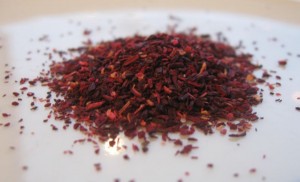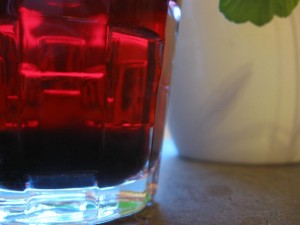Last updated: February 25, 2013
Hibiscus tea is made from the dried flowers of the plant Hibiscus sabdariffa. Other names for hibiscus tea include roselle, flor de Jamaica, karkadé, sorrel or red sorrel. Drunk in many forms around the world both hot and cold, it’s an extremely popular herbal tea with a rich history of use.
Appearance
Loose-leaf hibiscus tea is deeply and intensely red mottled with lighter sections. The tea should be made exclusively from the flowers of the hibiscus plant and not the leaves or any other part. (Technically, hibiscus tea is made from the calyx–the outer protective sheath–of the flower, rather than the petals.) The flowers may either be whole or crushed to a rough texture; they should not be powered. The dried tea has a distinct aroma: slightly acidic but sweet and floral.
Hibiscus tea recipe
Hibiscus flowers are very robust when it comes to making tea. Some delicate teas require cooler water and carefully-timed infusion, but with hibiscus feel free to use freshly boiled water and long infusion times–15 minutes or more.
Many traditional recipes call for simmering the flowers in boiling water for 10 to 15 minutes. Personally, I’ve found that simply brewing the tea with boiling water in a teapot or french press is more than adequate to extract intense color and flavor from the hibiscus. My method:
- In a large teapot or other container, add one teaspoon of crushed hibiscus tea (or about 5 whole dried hibiscus flowers) per cup of boiling water. Add the hibiscus first and pour the boiling water over it.
- Cover and leave to infuse. I’ve found that ten minutes is adequate when using crushed tea. With whole flowers, I would shoot for 15 minutes or longer.
- After the tea has reached your desired strength, remove it from the water; if your teapot has a strainer basket or you’re using a tea ball, remove it. If you’re using a french press, depress the plunger. Be warned, this tea stains.
- Add any additional flavorings and serve, or allow to cool and serve over ice.
Drinking hibiscus tea
Color: the tea is a shocking candy-apple red. The color is so bright it almost looks artificial. You’d be forgiven for thinking it was a caffeine-packed energy drink rather than a naturally brewed herbal tea. The color ranges to deep blood red to almost black.
Aroma: there’s a clear impression of sharp acidity along with a good dose of jammy stewed fruit. I’m reminded a little of hot apple cider. The acidity makes the biggest impression. It smells a little like the sharp kick of a strong balsamic vinegar, but with less funk.
Taste: the acidity is bracing. It tastes a little like an unsweetened vitamin C tablet. The sensation is mouth-puckering. There are complex notes of flowers, When held in the mouth, the taste verges on bitterness. When swallowed, the acidity is washed away.
It’s hard to overstate just how acidic this tea is. My teeth feel stripped after drinking it, a sensation I associate more with soda than tea.
As a rule, I never have sugar or honey in herbal tea, and I haven’t encountered any other tea that I felt suffered from not being sweet enough. However, due to it’s extreme acidity I decide to try hibiscus tea with sugar. Virtually every instance of traditional use I can find mentions adding sugar, honey or a similar sweetener.
After adding around a teaspoon of sugar to a small glass, the taste is markedly different–more like sour candy than vitamin C. It’s certainly more palatable and interesting, but still bracingly sharp. Incredibly, the sharpness feels almost more intense in the sweetened version. Without sugar, it feels like my taste buds simply give up in despair after the initial wave of acidity, but with sugar there’s just enough stuff happening in the background to keep them interested. The result is a more substantial and long-lasting sensation of sourness, but it’s more than compensated for by the taste of hot fruit which is now much easier to appreciate. I can now detect very pleasant notes of blackcurrant and citrus.
In the spirit of inquiry, I decide to add a second teaspoon of sugar. Finally, the acidity is tamed and relegated to a flavor rather than a tongue-tightening sensation. The fruit is now even more abundant. It tastes almost like a good punch or hot sangria.
However, if anything my teeth feel worse with the new sweetened version, which is as I’d expect–the sugar may tame the effects of the acidity on my taste buds, but it’s certainly not doing anything to correct its attacks on my tooth enamel.
Other flavorings
Traditionally, hibiscus tea is often made with other herbs and spices. Common additions include cinnamon, clove, nutmeg, ginger, mint or lemon. There are so many regional variations that I’m not able to test them all out, but I can readily believe that the jammy, fruity flavors of hibiscus and sugar would combine very nicely with spiced undertones.
Hibiscus tea benefits
Hibiscus tea and blood pressure
Recently, hibiscus tea has been getting a fair amount of attention for its supposed ability to lower blood pressure.
An upcoming review article by AL Hopkins et al. examines the evidence behind that claim.
The daily consumption of HS [hibiscus] calyx extracts significantly lowered SBP [systolic blood pressure] and DBP [diastolic blood pressure] in adults with pre to moderate essential hypertension and type 2 diabetes. [...] Regrettably many of the RCTs [randomized controlled trials] were of low quality and did a poor job characterizing the HS extracts and utilized a form that is not widely consumed making it difficult to determine the amount of public health benefit related to HS tea consumption. [...] As the findings related to the effects of HS on blood pressure from lower quality studies are consistent with those of this high quality study, the totality of evidence suggests that HS consumption may have a public health benefit due to its anti-hypertensive effects. Source: Hibiscus sabdariffa L. in the treatment of hypertension and hyperlipidemia: A comprehensive review of animal and human studies.
There’s promising evidence that hibiscus products may help reduce blood pressure, but as is so often the case in herbal medicine, there’s not enough high-quality evidence yet to reach a firm conclusion. Hopefully it goes without saying that anyone considering taking hibiscus tea to try to reduce blood pressure should talk with their doctor first, especially if they’re already taking medication.
Hibiscus tea and cholesterol
The same review quoted above also discussed the interaction of hibiscus with cholesterol:
Over half of the RCTs showed that daily consumption of HS tea or extracts had a favorable influence on lipid profiles including reduced total cholesterol, LDL-C ["bad" cholesterol], triglycerides as well as increased HDL-C ["good" cholesterol].
However, the same caveat applies: these are preliminary results which need to be tested by larger trials.
Hibiscus tea side effects
Hibiscus had a long history of nutritional and medicinal use and so is normally considered safe for most people at normal doses. However, some side effects have been reported.
Hibiscus tea is a diuretic, although it doesn’t appear to change electrolyte levels.1
Negative interactions with the diuretic drug hydrochlorothiazide (HCTZ) appear to be a concern,2 so people taking this drug should avoid hibiscus products.
Hibiscus tea has also been reported to reduce the effectiveness of acetaminophen (paracetamol) when taken within a few hours of the painkiller.3
Final Thoughts
Hibiscus makes for a really interesting herbal tea. The color and aroma of the dried hibiscus flowers is beautiful. The flavor of the unsweetened tea is startling; I can’t imagine many people drinking it for pleasure. With sugar, and, I’m sure, with other traditional flavorings, hibiscus tea is delicious, rich, complex and sophisticated.
However, speaking personally the necessity of adding sugar or other sweeteners is a huge drawback. One of the major attractions of herbal teas is how healthy they are. Adding sugar largely negates that. The tea is also extremely sour and I assume long-term use would contribute to acid erosion of tooth enamel.
The potential for hibiscus tea to lower blood pressure and cholesterol is interesting, but again I have to wonder about the long-term wisdom of drinking sugary tea every day in an effort to become healthier. If hibiscus does become a tried-and-tested treatment for high blood pressure, I image other delivery mechanisms will come to the fore to help people avoid the sugar trap.
- Clinical effects produced by a standardized herbal medicinal product of Hibiscus sabdariffa on patients with hypertension. A randomized, double-blind, lisinopril-controlled clinical trial. [↩]
- Herb-drug interaction between the extract of Hibiscus sabdariffa L. and hydrochlorothiazide in experimental animals. [↩]
- Effect of zobo drink (Hibiscus sabdariffa water extract) on the pharmacokinetics of acetaminophen in human volunteers. [↩]


